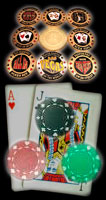Let’s analyze this. How likely is it that the raiser on the flop has a flush ?
To determine that, we need to do an inventory of the possible poker texas hand he might have, hands that would be consistent with the way that he’s played both before the flop and on the flop.
First, what hands would he play this aggressively (raising twice) on the flop? A flush for sure, but probably he’d also play a set or two pair that aggressively.
He might also play that aggressively with the K ![]() and a hand like A
and a hand like A ![]() K
K ![]() or K
or K ![]() Q
Q ![]() , Which of these hands might he actually have ?
, Which of these hands might he actually have ?
Before the flop the raiser had been on the big blind and the bet had been raised twice when the action got to him, and he called.
With seven players seeing the flop, he would likely have called with any of the poker hands listed in the table.
RAISER’S HAND
Likely hands of the flop raiser in our example hand.
Ax Ay
K ![]() Kx
Kx
Ax K ![]()
Ax 10x
K ![]() Qx
Qx
K ![]() Jx
Jx
Any two ![]() with one over an 8
with one over an 8
There are about forty-eight hands that a solid player might have which he’d be playing aggressively on the flop.
Of those hands, twenty-one of them would have our hand beat, twenty-seven would not.
Of the twenty-seven, twenty-one are hands that have draws to beat our small flush.
So if a solid player is playing a single-suited flop aggressively, and we have a small flush, we probably are not beaten.
He does, however, probably have a draw to beat our flush. In this case the best tactic to take is to take is to play aggressively on the flop and turn.
This is because, although a draw to a bigger flush has a good enough draw to profit from the poker odds he’ll probably get from the flop bets, the other draws are pretty much drawing dead, and the made flush benefits also from the bets on the flop.
In this situation the best draw and the best hand both benefit from bets and raises on the flop, as long as two or three other players with playing pocket pairs or worse flush draws are calling.
Of course, in our example there were many other callers who might have beaten us, but it’s not likely they’d passively call in this situation unless they had relatively weak draws such as Q ![]() Q
Q ![]() or J
or J ![]() 10
10 ![]() .
.
What did the other players have in our example hand with a flop A ![]() 10
10 ![]() 2
2 ![]() ? The aggressive raiser had A
? The aggressive raiser had A ![]() K
K ![]() , and one of the other players had Q
, and one of the other players had Q ![]() Q
Q ![]() .
.
The others didn’t show their hands but probably had some mix of weak draws or pairs.
Pick the Right Table / Picking a Seat / Theories of Poker / Betting Theory: The Odds
A Theory of Starting Hand Value
A Theory of Flop Play: Counting Outs and Evaluating Draws
The Dynamics of Game Conditions / Table Image / Player Stereotypes
Women and Poker / Spread-Limit Games / Double Bet on the End Games / Kill Games
Short-handed Games / Tournaments / No-limit and Pot-Limit Poker



